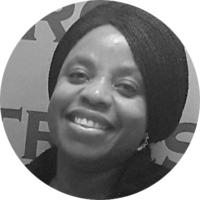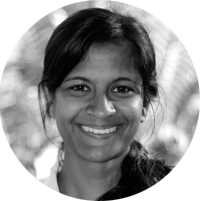PhD students
[/et_pb_team_member]
Takalani Girly Nemungadi
PhD Student
The National Department of Health has policy and implementation guidelines on regular treatment of school-going children for bilharzia. However, regular treatment or prevention chemotherapy to control schistosomiasis is not being implemented. Treatment is currently based on individual diagnosis at the health care facilities. The free generic treatment that is accredited by the WHO is not available to South Africans as it is not registered for use in South Africa. The drugs are prohibitively expensive.
The World Health Organisation (WHO) has concluded that it is biologically plausible that female genital schistosomiasis (FGS) is a risk factor for HIV transmission to women. Therefore, in our study we will explore young sexually active HIV+ve women divided into untreated FGS positive, treated FGS and FGS negative controls. Viral load and questionnaire data will explores. In addition laboratory data from the National Health Laboratory Service will be used to randomly sample individuals with high intensity infection; school nearest to the exposure site will be explored for intensity and prevalence, and treatment provided from the nearest clinics.
Completed PhDs

Hashini Nilushika Galappaththi-Arachchige
PhD 2019
Graduated as a medical doctor from the Medical University of Warzaw, Poland in 2009. Galappaththi- Arachchige has clinical work experience from the United Kingdom, Norway, and Kenya.
Summary
Dr Galappaththi-Arachchige explored the accuracy of four diagnostic tools. In this important work she shows we must think “out of the box” to identify Female Genital Schistosomiasis. She also described how river (and lake) water contact was associated with genital symptoms. The study was done in adolescent girls and young women aged 16-22 years.
Many school-going young women in Africa grow up in extreme poverty with a high prevalence of reproductive health issues, such as teenage pregnancy, HIV and sexually transmitted infections (STIs). In addition Bilharzia – Female Genital Schistosomiasis (FGS), is a neglected infection, is caused by a waterborne parasite. Women and girls suffer genital pain, malodorous discharge, infertility and many other problems.
Dr Galappaththi-Arachige is a recipient of grant from the South Eastern Norway Health Authority

Elisabeth Kleppa
PhD 2015
Graduated as a medical doctor from the University of Bergen, Norway in 2007, Kleppa completed her PhD in 2015. She worked as a medical doctor at Bærum Hospital, Norway, before she did her Diploma in Tropical Medicine and Hygiene (DTM&H) at the Liverpool School of Tropical Medicine in 2009. Her research focuses on the biological mechanisms behind the association between HIV and FGS.
Summary
More than 110 million Africans are estimated to be infected with Schistosoma (S.) haematobium, but it is still one of the so-called “neglected tropical diseases”. Poor countries bear the majority of the disease burden, contributing to the maintenance of the cycle of poverty.
In Africa, women are at a higher risk of human immunodeficiency virus (HIV) infection than men, and this cannot be explained by behavioural factors alone. Biological risk factors seem to contribute to the differences in HIV prevalence between geographical regions and genders. This thesis will focus on female genital schistosomiasis and cervical ectopy, both factors hypothesised to facilitate the transmission of HIV through the genital mucosa. Genital schistosomiasis in women is characterized by lesions referred to as “sandy patches” that appear grainy or homogenous and are thought to be caused by the deposition of ova in the genital tissues. Sandy patches are often associated with abnormal mucosal blood vessels and contact bleeding due to the fragile mucosa. Cervical ectopy and female genital schistosomiasis (FGS) may be diagnosed by photocolposcopic examination, and both conditions are likely to be present before sexual debut. In addition to increased susceptibility to HIV infection, S. haematobium infection has been suggested to accelerate the progression of HIV infection, possibly through increased immune activation.
In this study, South African women attending high schools in KwaZulu-Natal were included. Blood, urine and cervical lavage samples were collected and a photo-colposcopic examination performed.
We found that FGS was associated with a higher frequency of HIV target cells and HIV co-receptor expression in the genital compartment (the proportion of CD14+CCR5+ cells was higher in FGS positive (FGS+) than FGS-negative (FGS-), p = 0.036) and in blood (both the proportions of CD14+ cells (p = 0.042), and CD4+CCR5+ cells (p = 0.018) were higher in FGS+). Furthermore, praziquantel treatment decreased the proportion of HIV target cells in FGS-positive women. Both the CD14+ cell population and CCR5 expression by CD4+ cells decreased significantly in both compartments after anti-schistosomal treatment (p = 0.043 and 0.025, respectively). We found no significant difference in CD4 cell counts in women with or without S. haematobium infection. Furthermore, we found that cervical ectopy was associated with the prevalence of chlamydia infection (adjusted OR 1.78, p = 0.033) and with HIV infection in the youngest study subjects (OR 2.19, p = 0.014).
Future studies are needed to show whether treatment of schistosomiasis and/or intervention against cervical ectopy may become tools in the battle against the HIV epidemic.
Dr Kleppa is a recipient of grant from the South Eastern Norway Health Authority

Sigve Holmen
PhD 2017
Graduated as a medical doctor from the University of Oslo, Norway in 2009. Holmen worked as a University Lecturer for the University of Oslo and as a medical doctor in Harding Hospital. His PhD work explores computerised image analysis as a new tool in diagnosing female genital schistosomiasis in low-resource settings.
Summary
Mobile phones can now be used to diagnose the world’s second most common tropical disease after malaria! By taking pictures of the patient’s mucous membranes where the parasite has laid its eggs, computer image analysis can diagnose female genital schistosomiasis.
There are no good diagnostic tools for female genital schistosomiasis. We therefore wanted to find a simple, objective and automated way to diagnose this disease using digital image analysis. Our goal is to pave the way for a digital diagnostic tool that can be used in areas with little resources and a lack of health professionals with expertise in tropical medicine. Diagnostics in the form of software is easy to distribute – even to remote areas of Africa, thanks to the mobile revolution in recent years. The tool could be used on a variety of devices such as mobile phones, tablets, computers, or other, in the form of an “app” that you install.
We used colour analyses to identify the yellow areas characteristic of female genital schistosomiasis. In addition, we used image analysis to identify and characterise the abnormal blood vessels surrounding the lesions.We found that these are typical because they tend to appear in a circular configuration and that they have a more complex form than other abnormal blood vessels.
This automated digital image analysis represents the first step towards developing a diagnostic tool for use in areas where this disease is prevalent. Further research is needed to investigate how this tool can best be implemented in these areas and how well the diagnostic accuracy is in a real clinical situation.
Other students that have contributed
Published paper as first author
Ms Adele Munsami
Dr Ana Randjelovic (J)
Ms Andrea Lothe
Dr Anna Kildemoes
Dr Dina Edvarda Thomassen Morgas
Mr Edmore Mazani
Dr Elin Helland (J)
Dr Erik Egeland Christensen
Dr Hanne Marie Norseth
Dr Ingrid Elise Amlie Hegertun (J)
Dr Kristin M.S. Gundersen (J)
Ms Kundai Vickie Magaisa
Ms Mahala Livingstone
Dr Marije Baan
Dr Mari Molvik (J)
Mr Nkosinathi Banhela
Dr Simen Tveten Berge
Mr Siphosenkosi G. Zulu
Dr Solrun Søfteland
Dr Synne Grønvold Frønæs (J)
(J) Joint first authorship with one other author (equal contributions)

Pavitra Pillay
PhD 2016
Pillay graduated as a Medical Technologist in 1992 and worked as a cytotechnologist at Regional Laboratory Services, KZN, South Africa, before joining Durban University of Technology where she currently lectures to Medical Technology students. In 2004 she attained a Masters in Public Health from University of KwaZulu-Natal. Her research focuses on genital schistosomiasis as a risk factor for cervical cancer and on developing laboratory based diagnostic tools for FGS.

Nonhlahla Mbhata
PhD 2017
Graduated with M Med Sci (Medical Microbiology) from the University of KwaZulu-Natal, Durban, South Africa in 1999. She worked as a medical technologist in the pathology laboratory at the Edendale Hospital in Pietermaritzburg, South Africa before she joined Durban University of Technology in June 2003 where she is currently working. Her PhD focused on the high-risk HPV types distribution and persistence in young women in KwaZulu-Natal, South Africa and it also includes a study on self-sampling acceptability by young women in the same region.
Student assignments (Masters level)
Some of these have articles in progress
Ms Adele Munsami
Ms Andile Angel Maphumulo
Dr Ana Randjelovic
Ms Andrea Lothe
Dr Anna Kildemoes
Dr Camilla Kopperstad
Dr Cornelia Kristiansen
Dr Dina Edvarda Thomassen Morgas
Mr Edmore Mazani
Dr Elin Helland
Dr Erik Egeland Christensen
Dr Erika Carina Hallerstig
Dr Hanne Marie Norseth
Dr Hanne Asdal Eriksen
.
Dr Ingrid Homme Sørensen
Dr Ingrid Elise Amlie Hegertun
Dr Kristin M.S. Gundersen
Dr Kristine Hjetland
Dr Mari Elisabeth Bøe
Dr Mari Molvik
Dr Marije Baan
Mr Nkosinathi Banhela
Ms Nqobile Ntokozo Zulu
Dr Oda Lommerud Jørgensen
Dr Simen Tveten Berge
Mr Siphosenkosi G. Zulu
Dr Solrun Søfteland
Dr Synne Grønvold Frønæs
Dr Una Kristin Waldeland
Dr Vera Vik Bjarkø
Short-term visiting scientists who are writing papers
Dr Christine Aurlund
Dr Jilna Shukla
Honorary recipients of Marie Curie Fellowships
Early stage researchers, technical staff and trainers
Anna Kildemoes, Andile Maphumulo, Andile Mtshali, Andrea Lothe, Anele Kwitshana, Audun Klyve Gulbrandsen, Carolyn Ester Clark, Christine Aurlund, Debbie Clark, Elisabeth Kleppa, Gitte Garvik, Hashini Nilushika Galappaththi-Arachchige, Hege Lovise Lundgren, Ida Amelie Nomusa Helgesen Mayes, Halfdan Kjetland, Hanne Marie Norseth, Håvard Holme, Ingrid Elise Amlie Hegertun, Ingrid Lindstrøm, John Erik Adolf Armelius, Joyce Nonhlanhla Mbathi, Kari Klinge, Kristine Lillebø, Kumud Nina Henriksen, Lars Lwazi Holten, Leah Nga Tran, Linnea Sund Stråbø, Lotte Straathof, Marije Baan, Pavitra Pillay, Sara Rose, Sigve Holmen, Siphosenkosi Gift Zulu, Susanne S. Klungtvedt.
(PIRSES-269245)
